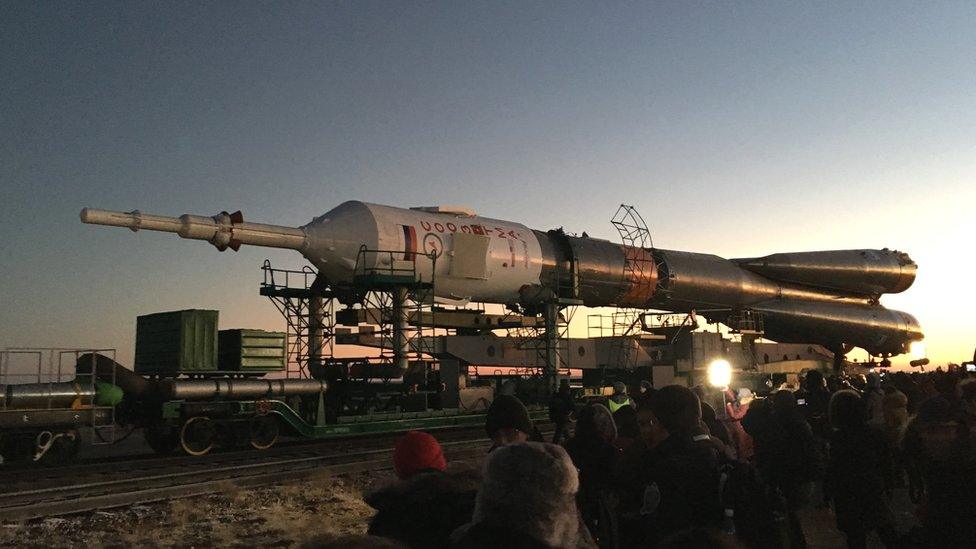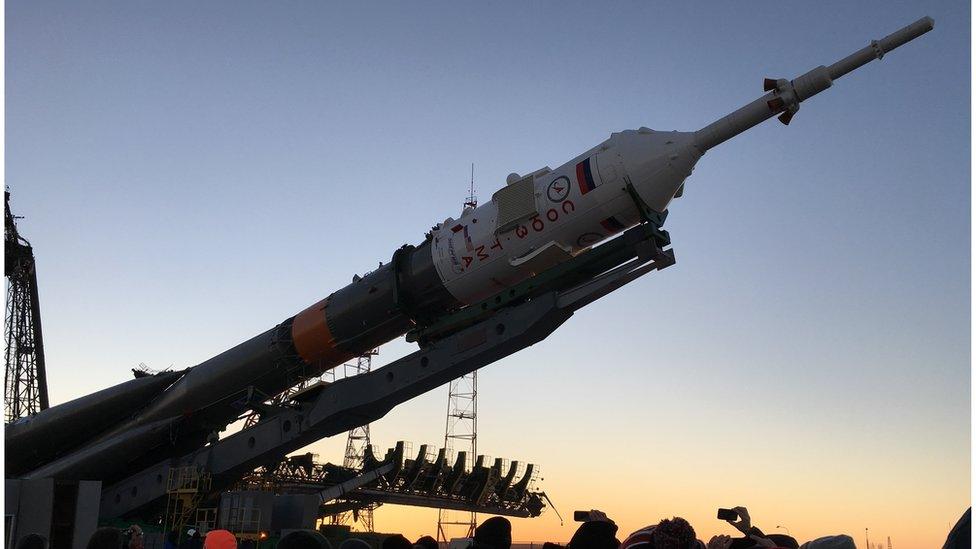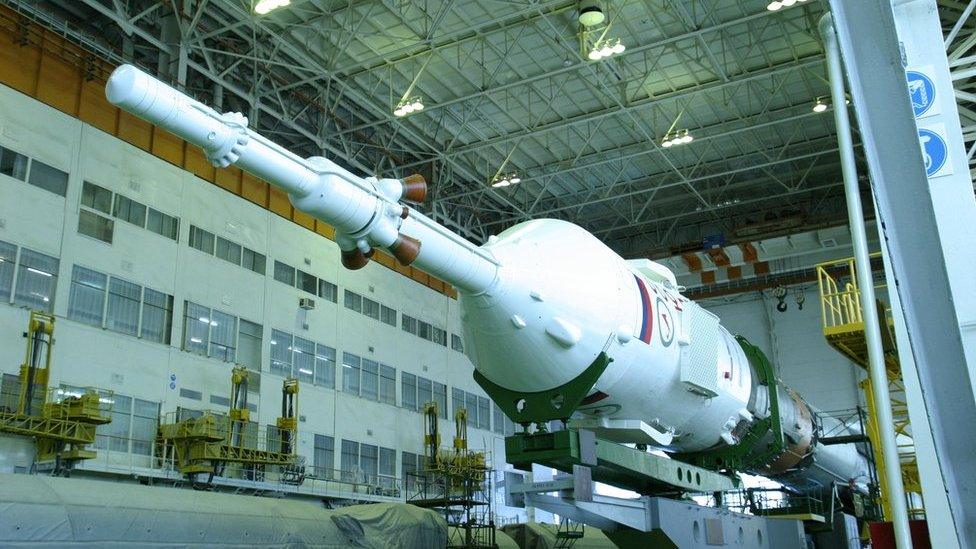Tim Peake: Rocket rolled to launch pad
- Published
Sarah Rainsford watched the Soyuz space craft's journey to the launch site
The rocket that will carry UK astronaut Tim Peake into orbit has arrived at the launch pad in Baikonur, Kazakhstan.
At 01:00 GMT (07:00 local time), the Soyuz launcher was rolled out on its flat-bed transporter for the 2km train journey to the pad.
The train took almost two hours to reach the pad, known as Site No 1.
Mr Peake will be accompanied by American Tim Kopra and Russian Yuri Malenchenko on Tuesday's flight to the International Space Station (ISS).
It should take the astronauts about six hours to reach the orbiting outpost, where they will dock and join the crew of three already stationed there.
Astronauts' relatives, members of the back-up crew, space agency officials and journalists were among the visitors gathered to see the rocket rolled out of its hangar and lifted to the vertical position at the launch site where Yuri Gagarin became the first human to blast into space in 1961.
Among them were Tim Peake's parents, Angela and Nigel.
Angela Peake told BBC News it was "fantastic" to be at Baikonur for her son's launch, adding she was immensely proud of him.
Nigel Peake said: "[Tim] is raring to go now. He's trained, he's ready, he's happy. They're all together and just waiting for the big lift-off."
He added he was "a bit over-awed" at the "scale of the operation".


Tim Peake in space: Want to know more?
Special report page: For the latest news, analysis and video
Video: How the view from space affects your mind
Graphics: What's it like to live and work in space?
Explainer: The journey into space

German-born Alexander Gerst, who was one of the other five European Space Agency (Esa) astronauts selected along with Mr Peake in 2009, told me: "I met Tim yesterday, he's in very good spirits, and he's looking forward to it."
Mr Gerst, who flew to the ISS in 2014, added: "It's going to be an amazing ride for him - I'm jealous! He really deserves his flight, but I told him: 'If you have another seat up there in the spaceship I'll come with you."
It was a bitterly cold morning here at Baikonur Cosmodrome, as a diesel locomotive was backed up to the door of the giant hangar-like facility known as Building 112, in readiness to haul the rocket along a railway track to its destination.
As the shutters lifted in the darkness, revealing the building's illuminated interior, there was excitement as the crowd glimpsed the red nozzles and polished metal of the Soyuz rocket's "business end". The locomotive sounded its whistle and sped past us, with the launcher and its transporter in tow.
We then decamped to a railway crossing, trudging across the hard-frozen ground to watch the last leg of this carefully choreographed performance as the launcher advanced down the final stretch of track to the launch site known informally as Gagarin's Start.
Once it arrived, the rocket was to be raised up and encased within the arms of its service structure.

Follow the launch
The BBC has had unique behind-the-scenes access to Tim Peake's training and launch.
Follow his video diaries on Horizon - Tim Peake Special: How To Be An Astronaut and watch the launch live on Blast Off Live - A Stargazing Live Special at 10:30 GMT on Tuesday 15 December.
You can also see him arrive on the International Space Station, at 19:00 GMT the same evening, on BBC Two in Stargazing Live: Brit In Space.


The train took one hour 45 minutes to haul the launcher to the pad

Crowds gathered at a crossroads to watch the rocket make its final approach to the launch pad
Here to see the rocket arrive was David Willetts, the former UK science minister, who is regarded by many as the architect behind Tim Peake's mission to the ISS.
I asked him what it was like to see the plans come to fruition.
"It's incredibly exciting. It's been a long journey from those negotiations with the European Space Agency in 2012. That's when I changed the policy and we moved into participating in manned missions. The fact he's going to do some great science while he's up there has justified that decision.
The UK government had traditionally been opposed to financing activities associated with human spaceflight. So previous British spacefarers, such as Helen Sharman who flew to Mir in 1991, were required to seek alternative forms of funding.
Mr Peake was selected by ESA from a pool of 8,000 applicants in 2009 but, explained Mr Willetts, "he was on the training programme, but was not part of the manned flight programme".
He added: "Sadly he was very unlikely to get a flight up to the space station, because Britain was not participating in the ISS."
"The sheer excitement of having the first official British astronaut reminds people that we are a leading scientific power. We can do this type of thing, we can participate in space and we have a great space industry."

The rocket was raised into the vertical position at the pad - known informally as Gagarin's Start
The mission's commander, Yuri Malenchenko, is one of the Russian Space Agency's (Roscosmos) most experienced cosmonauts. He has spent a total of 641 days in space, over five flights.
This will be the second flight for Timothy Kopra, who spent 60 days aboard the ISS in 2009. The US Army colonel was subsequently assigned to the final mission of space shuttle Discovery in 2011, but was replaced after being injured in a bike accident.
Bill Gerstenmaier, Nasa's chief of ISS operations, told me: "We've called it the Tim And Tim mission… It's interesting to see people from other countries getting excited about their astronauts flying."
"It will be great to have six crew back on orbit, getting ready to keep doing the research on board the space station."
On the topic of the space station's longevity he said: "We're working until 2024 on the ISS, the Russians have indicated that [date], the Japanese are also in the process of approving it and so has ESA.
"We look at that as nine more years where we'll have lots of productive research. We're starting to see lots of interest from companies - not just aerospace companies - who want to do research in space."
Follow Paul on Twitter., external
- Published12 December 2015

- Published10 December 2015
